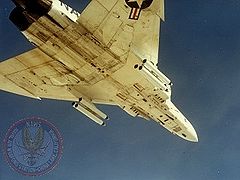
AIM-95 Agile
Encyclopedia

Air-to-air missile
An air-to-air missile is a missile fired from an aircraft for the purpose of destroying another aircraft. AAMs are typically powered by one or more rocket motors, usually solid fuelled but sometimes liquid fuelled...
developed by the United States of America. It was developed by the US Navy to equip the F-14 Tomcat
F-14 Tomcat
The Grumman F-14 Tomcat is a supersonic, twin-engine, two-seat, variable-sweep wing fighter aircraft. The Tomcat was developed for the United States Navy's Naval Fighter Experimental program following the collapse of the F-111B project...
, replacing the AIM-9 Sidewinder
AIM-9 Sidewinder
The AIM-9 Sidewinder is a heat-seeking, short-range, air-to-air missile carried mostly by fighter aircraft and recently, certain gunship helicopters. The missile entered service with United States Air Force in the early 1950s, and variants and upgrades remain in active service with many air forces...
. Around the same time, the US Air Force was designing the AIM-82
AIM-82
The AIM-82 was a missile planned by the United States of America but cancelled before any prototypes were built.-Overview:In 1969 the US Air Force was developing the F-15 Eagle fighter. Planned as the ultimate air superiority aircraft, the F-15 was intended to be as perfect as possible in every...
to equip their F-15 Eagle
F-15 Eagle
The McDonnell Douglas F-15 Eagle is a twin-engine, all-weather tactical fighter designed by McDonnell Douglas to gain and maintain air superiority in aerial combat. It is considered among the most successful modern fighters with over 100 aerial combat victories with no losses in dogfights...
, and later dropped their efforts to join the Agile program. In the end, newer versions of Sidewinder would close the performance gap so much that the Agile program was cancelled.
Overview
The AIM-95 was developed at the China Lake Naval Weapons Center as an advanced replacement for the AIM-9 SidewinderAIM-9 Sidewinder
The AIM-9 Sidewinder is a heat-seeking, short-range, air-to-air missile carried mostly by fighter aircraft and recently, certain gunship helicopters. The missile entered service with United States Air Force in the early 1950s, and variants and upgrades remain in active service with many air forces...
short range air-to-air missile
Air-to-air missile
An air-to-air missile is a missile fired from an aircraft for the purpose of destroying another aircraft. AAMs are typically powered by one or more rocket motors, usually solid fuelled but sometimes liquid fuelled...
. The Agile was equipped with an infrared seeker for fire and forget operation. The seeker head had a high off-boresight lock-on capability capable of being targeted by a Helmet Mounted Sight (HMS), allowing it to be fired at targets which were not directly ahead—thus making it far easier to achieve a firing position. The solid-propellant rocket used thrust vectoring for control giving it superior turning capability over the Sidewinder.
The US Air Force was developing the AIM-82
AIM-82
The AIM-82 was a missile planned by the United States of America but cancelled before any prototypes were built.-Overview:In 1969 the US Air Force was developing the F-15 Eagle fighter. Planned as the ultimate air superiority aircraft, the F-15 was intended to be as perfect as possible in every...
missile to equip the F-15 Eagle
F-15 Eagle
The McDonnell Douglas F-15 Eagle is a twin-engine, all-weather tactical fighter designed by McDonnell Douglas to gain and maintain air superiority in aerial combat. It is considered among the most successful modern fighters with over 100 aerial combat victories with no losses in dogfights...
at the same time. Since both missiles were more or less identical in their role, it was decided to abandon the AIM-82 in favour of the Agile.
AIMVAL

ACEVAL/AIMVAL
The Air Combat Evaluation and the Air Intercept Missile Evaluation were two back-to-back Joint Test & Evaluations chartered by the United States Department of Defense that ran from 1974-78 at Nellis Air Force Base in Nevada. Both the U. S...
Joint Test & Evaluation conducted with both the F-14 and F-15 at Nellis AFB in 1975-78. AIMVAL analysis results indicating limited utility of higher high boresight capability and high cost resulted in opinion that it was no longer regarded as affordable and the project was cancelled in 1975. Instead an improved version of the Sidewinder was developed for use by both the Air Force and Navy. Although this was intended to be an interim solution, in fact the AIM-9 continues in service today.
The Soviet Union did embark on development of an advanced high boresight SRM with thrust vectoring and subsequently fielded the AA-11/R-73 Archer on the MiG-29 in 1985.

